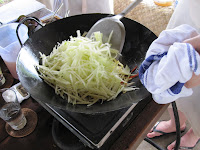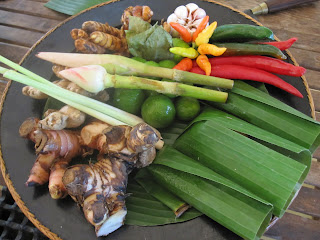The cooking class was held in an open-air room with a thatched roof. Everyone in the class had a workstation with a burner, ulekan grinding stone, a packet of recipes, and small dishes of ingredients. We were glad to be in a covered space because mid-way through the class the heavens opened and it poured down rain. We were quite snug. Did I mention that I was the lone American in the group? Eight Australians and me.
Chef Santika opened the class with explanations of the ingredients we would be using for our lunch: the various kinds of rice and beans and the vegetables that would comprise
Bumbu Bali.
Pak Sugita built a fire in the stove over which several of our dishes would cook.
We were set.
We started the class by making
Bumbu Bali. Most of the ingredients are pictured here. Check my
Bumbu Bali blog posted on July 29 and dated July 2 for lots of information about this useful paste, used to create so many Balinese dishes. Once it was simmering, we proceeded to prepare our lunch, carefully walked through the process by Santika.
Sate lilit babi, Pork Sate on Lemongrass. This version of sate is made with ground pork and mixed with fried shallots, garlic, Bumbu Bali, coconut milk and lime juice. The mixture is wrapped around the end of a stalk of lemongrass and is grilled. There is a special method which Santika demonstrated to make sure the meat stays on the stalk. Soooo good and so much fun to eat.
Tum ayam, Spiced Chicken Parcels. Ever-useful banana leaves are used to wrap up the mixture of chopped chicken coconut, Bumbu Bali, coconut milk, shallots, lemon basil, and lime juice. We put the little packets in the basket of a steamer which was sitting on the fire place. A great mixture. I could imagine making little packets out of aluminum foil—given the fact that banana leaves are not readily available. Why didn't I take a picture of what was inside?
Lawar don tabie bun, Bali Pepper Leaf with Grated Coconut and Red Beans. Spinach, bean sprouts or snow peas could be substituted for the Bali pepper leaves which are not readily available outside Bali. The greens are blanched, cooled, and mixed with grated coconut, fried chiles, shallots, and garlic, lime juice, and cooked red or black beans.
Tumis jepang, Stir-fried Choko (what we would call Chayote). Sliced chayote, red chiles, and garlic are sautéed in coconut oil. Stock, fish sauce, and oyster sauce are added and when everything is cooked, some sweet potato leaves or spinach are stirred in just before serving.
Nasi goreng, Balinese Fried Red Rice. This was the very same recipe we cooked in the first class except that this time we used cooked red rice. You can see how we left the coconut bowls resting gently over the mounds of rice to keep the bugs away while we finished preparing the lunch.
We had two sweets which the chef’s two assistants provided for us:
Urab sele, Sweet Potato Salad with Grated Coconut. It really wasn’t a salad in our sense of the word. It was several slices of boiled sweet potatoes, sprinkled with grated coconut and drizzled with palm sugar.
Lak lak, Tiny Rice Cakes. They were cooked in terracotta over the fire and served with fresh coconut and palm sugar.
It was a fantastic lunch, perhaps even better than the first cooking class lunch.
 So I have reached the end of the Bali blogs. As you can tell, it was a terrific trip, full of fun and adventures, many of which I have now written up. It was also deeply restful, especially so because, after the first few posts, I decided not to blog and instead to enjoy the experience fully, without getting near a computer. It was the right decision. We walked, sat by the pool, looked at the ocean and read good books. We went to a Balinese healer for some body work and to a Balinese holy man for some spiritual guidance. We enjoyed our time with Ben and Stephanie so much. We loved doing all the things I've now shared with you. And yes, to say it one more time, the food, oh the food, was just superb.
So I have reached the end of the Bali blogs. As you can tell, it was a terrific trip, full of fun and adventures, many of which I have now written up. It was also deeply restful, especially so because, after the first few posts, I decided not to blog and instead to enjoy the experience fully, without getting near a computer. It was the right decision. We walked, sat by the pool, looked at the ocean and read good books. We went to a Balinese healer for some body work and to a Balinese holy man for some spiritual guidance. We enjoyed our time with Ben and Stephanie so much. We loved doing all the things I've now shared with you. And yes, to say it one more time, the food, oh the food, was just superb.

















































